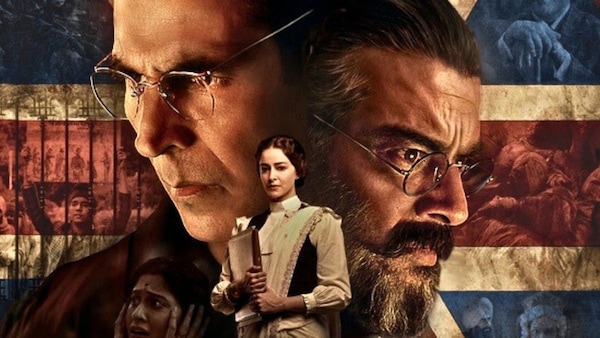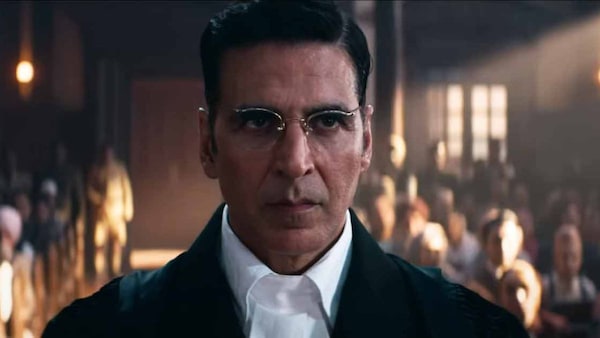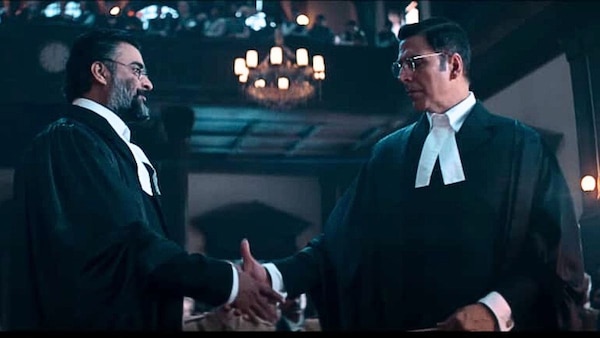Kesari Chapter 2: Akshay Kumar Hijacks Jallianwala Bagh Tragedy
Kesari Chapter 2 is a revival of old-school politics where the antagonism against the British, the original outsider, confirms the communal unity of India.

Promo poster for Kesari Chapter 2.
Last Updated: 10.50 PM, Apr 18, 2025
KARAN SINGH TYAGI’s Kesari Chapter 2: The Untold Story of Jallianwala Bagh is based on a book that is based on a 1924 defamation case filed by a former British Lieutenant Governor of Punjab against an Indian lawyer. The film, however, unfolds as a series of court proceedings that purports that the Indian lawyer had sued the Crown. This flip in premise is slight but definite, pointing to Hindi films’ increasing tendency of revisiting the past only to champion a hero, even at the cost of altering it.
Kesari Chapter 2, the spiritual sequel to Anurag Singh’s Kesari (2019), deals with the 1919 Jallianwala Bagh massacre where over 1000 people were shot dead at a peaceful gathering in Amritsar by the British military officer Reginald Dyer. Although this forms the centerpiece, the film concerns itself with the premeditated way the British assembled the crowd on April 13, and conveys it through speculative rendering of a court case.

This can be a deviation from facts but not fiction. Earlier this year Ram Madhvani had done something similar in The Waking of a Nation, a bloated historical series that focussed on the conspiracy hatched by the British to kill Indians on that specific day. Kesari Chapter 2 follows a similar arc and while Madhvani alluded to the fictional undertones by using fictitious names, Tyagi’s film doubles down on its authenticity by resorting to no such shield. Therefore, Justice Chettoor Sankaran Nair (played by Akshay Kumar, of course), the real-life celebrated barrister who had accused Michael O’Dwyer at the time of the massacre and was thus taken to court, holds General Dyer accountable in court in the retelling for murdering innocent people. He is helped by co-council Dilreet Gill (Ananya Panday) and challenged by British advocate Neville McKinley (R. Madhavan). And through the runtime of the case, familiar details of the Jallianwala Bagh emerge, a lot of which is available on Wikipedia.
Not much in Tyagi’s film is particularly “untold” except perhaps it's psychoanalysing of Dyer. But what it does within this setting is worth noting. With Kesari Chapter 2, Dharma Productions continues doing what it had attempted with Ae Watan Mere Watan (2024): a revival of old-school politics where the antagonism against the British, the original outsider, confirms the communal unity of India. But even when the film resists easy propaganda, it puts up no fight in committing to the mould used by propaganda films.

As an upshot, Kesari 2 deploys the very familiar ‘us vs them’ narrative where both are depicted with extreme embellishments. All the Britishers in the film, right from General Dyer (Simon Paisley Day) to Michael O'Dwyer (Mark Bennington) are tainted with degrees of savagery similar to what minorities are held guilty of in Hindi films lately. The heroes or the Indians, on the other hand, are elevated to extreme heights and the greatness is reiterated through a crude detour of false rape charges levelled by a British woman. Although superfluous the design is recognisable but with a film like Kesari Chapter 2, this template of unfiltered hero-worship ends up undermining the very tragedy it had set out to depict.
The film opens with a recreation of the massacre and the claustrophobia of the stampede is craftily evoked through an immersive shot of a child gasping for breath. The scene ends soon and the ambition dissipates. Post this, Kesari Chapter 2 works overtime to orchestrate the many hero entries of Kumar, who is so eager to play the savior that the initial stretches of his allyship with the British is half-hearted at best. A hyperactive background score times his every step as he enters a courtroom, takes pauses and even exits with a showy style. In one scene, the actor slo-mo walks even in an empty courtroom.
This obtrusive style reinforces a major blindspot of the film that mistakes bravery with heroism. One thrives in loneliness and the other demands a crowd. Kumar as Nair is always sauntering to conclusions. He is bristling with rage and putting up a show. The writing, as is often the case with such films, affords the character no breathing space to be human which, in hindsight, dehumanises the fearlessness of Nair- a fascinating personality who was critical of Gandhi, fought the defamation case against the Crown and refused to apologise till the end.

Kesari Chapter 2 extends a similar blanket persona to Madhavan, an actor anyway prone to theatrics. The one who rises above the limiting framework is Panday. As Gill, a young female advocate who plays a crucial role in turning the gaze of Nair towards the victims of the tragedy, she is not just watchable but leaves a deep imprint with her turn. In many ways, essaying a character in a pre-Independent India, is a rite of passage for Panday who has hitherto played many iterations of the GenZ. This is a persuasive performance that leans on conviction and assured enunciation.
Notwithstanding the fate of the film, it is amply clear by now that Kesari has become a franchise of sorts that will retell untold stories of India from the past. On paper, it is a compelling idea given how actively Hindi films are challenging history by distorting it. A reiteration of how things used to be is a welcome change. But if the sophomore chapter confirms anything, it is that the saffronisation has sunk so deep in Hindi cinema that even when makers are not telling the same story, they are telling the same story.
Disclaimer: The views expressed in this column are those of the author and do not necessarily reflect the official policy or position of OTTplay. The author is solely responsible for any claims arising out of the content of this column.
